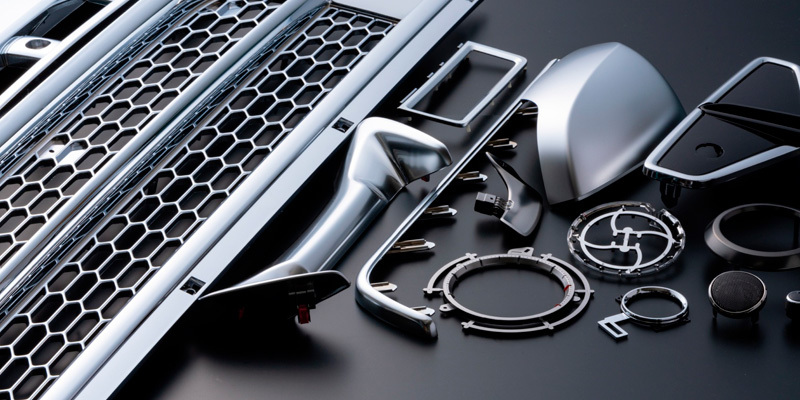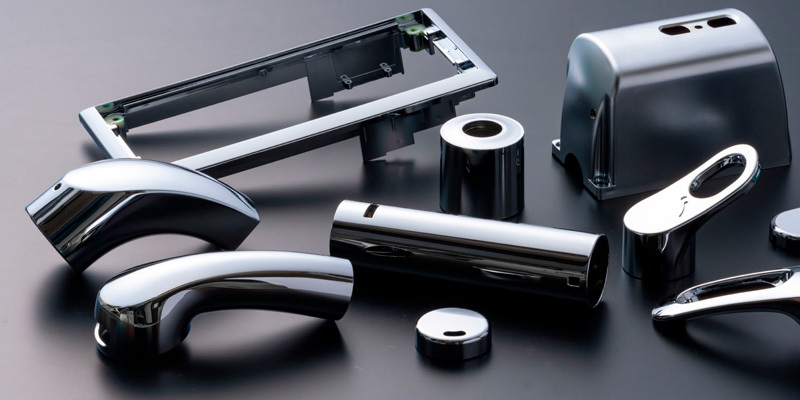Do you understand the selection, application and future of automotive interior and exterior decoration materials?
Release Time:
2022-11-30 10:27
With the rapid promotion of China's automotive industry status in the world, people's ability to comprehensively evaluate the performance of automobile products has been strengthened, and the requirements for the shape and structure of automobiles have become more stringent. Automotive interior and exterior decoration products are not only an element, but also a product highlight. In order to meet the requirements of users for car comfort and environmental protection, in addition to the extraordinary overall structure design, the selection of automotive interior and exterior decoration materials is also the key.
The selection of automotive interior and exterior decoration materials has become an important subject in the automotive industry
Automotive plastic has many advantages that traditional materials do not have, which are mainly manifested in light weight, good appearance decoration effect, a variety of practical application functions, good physical and chemical properties, easy processing and molding, energy saving, sustainable utilization and other aspects.
The application in automobile exterior assembly is to replace steel with plastic to reduce the weight of automobile. Main applications include: bumper, fender, wheel cover, radiator grille, spoiler, etc.
The application in the automotive interior assembly is for safety, environmental protection and comfort. The main applications include: instrument panel, door inner panel, sub-instrument panel, utility box, rear seat protection panel, etc.
Structural parts and functional parts are mainly made of high strength engineering plastics. The main applications include: oil tank, radiator water chamber, air filter housing, fan blade, etc.
The main ways of automobile lightweight are the use of lightweight materials, the innovation of processing technology and the optimization of automobile structure. The application of lightweight materials shows that multi-material structure can not only reduce the weight of automobile, but also improve its performance.
Due to its low density, corrosion resistance, sound insulation and other characteristics, plastic is widely used on the car door, fender, seat bracket, handle, body interior and exterior decoration. Using waste plastic as raw material, the body does not need to paint, not only recycling materials and reduce the weight of the car. To achieve plastic replacement of steel, such as the door plate to achieve plastic modular. In order to meet the requirements of the conditions preferentially selected with lower density materials. Micro-foaming technology is used to further reduce the density of the material, and high flow and high rigidity materials are developed to reduce the wall thickness of the product.
What are the standards for the selection of automotive interior materials?
The selection of automotive interior materials, in addition to the overall appearance of generous, the most important thing is to choose low VOC emission materials, to avoid the existence of this "invisible killer", plastic parts comfortable and safe, low VOC.
In the Made in China 2025 issued by The State Council in 2015, carbon fiber and its composite auto parts technology has been clearly regarded as an important development direction in the field of energy-saving and new energy vehicles. On January 1, 2017, the country began to implement the stricter National Ⅴ emission standards, which put forward higher requirements for vehicle emissions. From January 1, 2020, 95% of new cars sold in the European Union will have to emit an average of 95g/km of CO2, down from 130g/km currently.
For safety and environmental protection, the main choice of environmental protection materials to improve the vehicle air quality, reduce the harm of VOC gas to the human body; In terms of comfort, it is mainly to achieve advanced interior decoration, soft decoration, personalized.
At present, the way of automotive lightweight is to develop and use lightweight materials, design and optimize the structure, and use lightweight manufacturing technology. The high performance fiber reinforced composite is the most effective way to achieve lightweight.
Plastic parts low cost, easy to recycle, in the requirements of various performance at the same time, can not ignore the cost and environmental problems. After all, these requirements are at odds with recyclability and cost reduction. Therefore, the new interior materials should not only ensure that there is no increase in costs and can meet the requirements of comfort, safety and environmental protection. Can meet the performance requirements, but also reduce the cost, easy to recycle after waste.
Modified plastics used in vehicle interior trim
Car interior is not only the space for users to complete driving tasks, but also the carrier to realize users' expectations, bearing taste, identity, hobbies and other advanced emotional needs.
Nowadays, there are more and more vehicles in our country, and the development of automobile industry is growing. Under the trend of small and lightweight automobile manufacturing, engineering plastics are increasingly applied to the manufacturing process of automobile, which effectively improves the technology level and performance of automobile.
Among the types of automobile materials, metal and plastic composite materials will become more and more popular, which integrates the double advantages of metal and plastic materials, and can improve the overall manufacturing level of interior and exterior decoration of the car body.
For safety, environmental protection and comfort, the general requirements of the interior material must have the following characteristics: good strength and stiffness, can withstand a certain impact load; Good dimensional stability, especially high temperature stability; Good UV resistance linearity and weather resistance, can ensure more than 10 years of service life; Good solvent resistance; Low odor; Matte finish.
In general, low odor and matte finish are especially important for interior materials as long as basic mechanical and thermal properties are met. This is because the car interior is in a relatively closed environment for a long time. Under certain temperature conditions, small molecules of organic matter in plastic are easy to migrate to the surface of plastic products and volatilize out, causing harm to human body.
In addition, if the matte quality of interior materials is not good, it is easy to lead to strong reflection of light in the driving room, which not only affects the vision of drivers, but also easily causes discomfort and fatigue, resulting in traffic accidents. To that end, automakers are taking extra care in choosing interior materials.
From the type of interior materials, the instrument panel mostly uses PP, ABS, ABS+PC or SMA+GF and other materials, the door panel mostly uses PP, PP+EPDM, ABS or PC/ABS and other materials, defogging grates, handles and glove boxes are ABS, PC/ABS or PP and other materials. The air conditioning outlet generally uses ABS, PC/ABS or PA/ABS materials.
A car is the most easy to shine is the interior, because the appearance of the car is for others to see, and people really enjoy the interior of the car, the interior emphasizes the touch, feel, comfort and visibility.
Automotive interior parts include: compartment partition, door decorative panel, instrument panel, handrail, carpet, door handle, decorative strip, etc. Automotive commonly used interior plastic ABS, alloy, PP is the largest amount of several plastics, PP has PP long glass fiber, PP EPDM 20%MD, PP Talc and other materials, the application field is very wide: internal column decoration board, instrument panel skeleton, glove box cover plate and so on; ABS has different heat resistance levels, electroplating grade, no spraying low gloss, mainly used in door handrails, cup holders, electroplating trim and so on; PC/ABS is mainly divided into different heat resistant levels of PC/ABS, electroplating, spraying free PC/ABS, mainly used in the instrument panel skeleton, door plate skeleton, air conditioning outlet panel and other components.
These are several commonly used plastics for automotive interiors and their applications. Combined with the current problems of interior air quality, the development of low emission interior plastic is bound to be one of the development trends of automotive interior plastic.
Modified plastics for automotive exterior trim
In the field of automotive exterior decoration application, engineering plastics should not only be able to withstand a huge load, but also have outstanding ultraviolet and chemical corrosion resistance (such as cleaning agents) performance, and need to meet the higher requirements of appearance.
Automotive plastics have many advantages that traditional materials do not have, which are mainly manifested in light weight, good appearance decoration effect, a variety of practical application functions, good physical and chemical properties, easy processing and molding, energy saving, sustainable utilization and other aspects.
Automotive exterior parts are the parts system with the most plastic materials, mainly including bumper, rearview mirror, lights, door handles, intake grille, skylight and so on.
In the field of automobile exterior decoration application, engineering plastics should not only be able to withstand huge load, but also have outstanding ultraviolet and chemical corrosion resistance, and need to meet the higher requirements of appearance. In terms of the types of exterior materials, the main plastics used for automotive exterior are PP, PA, ABS, PBT and so on. For example, the external rearview mirror mainly uses heat-resistant ABS,PC/ABS,ASA, PBT+GF and other materials; Hubcaps are mostly made of PC/ABS, electroplated PC/ABS, heat-resistant ABS, electroplated ABS, PA/PPE and other materials; The cooling grid is PC/ABS, electroplated PC/ABS,ASA, electroplated ABS, AES, heat-resistant ABS and other materials; Column decoration plate: generally choose PC/ABS, ASA,M-PMMA,AES materials.
As one of the parts with the largest amount of plastic, the amount of plastic in the bumper occupies more than 40% of the total amount of the car body. Its composition is generally molded plastic sheet, and glass fiber is commonly used for blister or injection molding. The obvious characteristics of the bumper made of plastic materials are: low cost, easy processing, recyclable and light weight.
The radiator grille is used to cool the engine and is located in the front of the car. Usually, the grille of the car is made of ABS, which is conducive to the reduction of the grinding time of the components and the improvement of the high temperature tolerance. The fender is designed to prevent mud from splashing under the car while it is running, and is generally made of materials that are resistant to aging and weather.
When making side collision strips, recyclable and lightweight materials are usually selected. For example, the collision strips of Jetta are made of PP material.
Development and application of emerging automotive materials
The application of new materials is one of the main applications to realize the development of automobiles, and has also become an important scientific and technological topic in the present and future. Emerging materials have been widely used in the manufacturing and production of various processes, ranging from the manufacture of daily objects to the use of vehicles and other vehicles. High-quality emerging automotive materials are playing an important role in them.
There is no doubt that the development and application of emerging materials (such as nanocomposites, LGF-PP and bioplastics with strong environmental performance, etc.) has made the plastic application of automotive interior and exterior decoration more extensive. And the reflective characteristics of emerging materials, high-quality soft touch, ability to absorb impact and strong comfortable experience, etc., make it more inclined to the integration and application of plastic in the production of interior and exterior decoration.
Nano composite material
Nanocomposites take the matrix of resin, rubber, ceramics and metal as the continuous phase, and the modified metal, semiconductor, rigid particles and other inorganic particles, fibers and carbon nanotubes as the dispersed phase. Through the appropriate preparation method, the modifier is uniformly dispersed in the matrix material to form a composite system containing nano-sized materials. This system of materials is called nanocomposites.
Nanocomposites are a combination of polymers, fibers, rubber and nanomaterials in the three major areas of synthetic materials. Compared with traditional materials, nanocomposites have excellent properties. For example, due to the excellent surface interface effect, small size effect and quantum size effect of the nanoparticle, the nanoparticle, combined with the excellent characteristics of the polymer such as low density, corrosion resistance and easy processing, presents a different performance from the conventional polymer composites.
Because of the simple processing and obvious effect, the industry is optimistic about the market prospect of polymer nanocomposites. At present, all countries in the world are actively developing nanocomposites, and the application of nanotechnology in the field of plastics, chemical fiber and rubber raw materials is remarkable.
In the field of nanoplastics, the rise of polymer nanocomposites has injected new vitality into the traditional plastic industry. Compared with the traditional plastic materials, the polymer/nanocomposites showed better comprehensive properties. In the research and development of plastic materials in our country, there is a long time to develop nanomaterials, and the historic breakthrough in technology has been achieved. In use, nanomaterials use characteristics include: low cost, superior performance, wide range of use, etc.
And then invented a new type of nano composite material, which is mainly composed of organic polymer matrix and at least one dimension is not more than 100 nm nano inorganic dispersed phase, the excellent properties of this material include: high strength, stable color, high UV resistance, good flame retardant ability, light weight, excellent barrier and good processing performance.
In addition, because of their high plasticity, strong gloss and transparency, plastics produced by nanotechnology have been widely used in automobile radiator and chassis components.
LGF-PP (Long glass fiber reinforced polypropylene)
LGF-PP (long glass fiber reinforced polypropylene) is a kind of composite material with high elastic modulus, the length of glass fiber is between 12 ~ 25 nm, the remarkable characteristics are: low density, high strength, toughness, modulus, low temperature resistance and fatigue resistance characteristics are better, and affordable, recyclable application of superior performance.
In addition, LGF-PP has better molding and mechanical properties, which is increasingly favored by many developers. As the vehicle module carrier material, the material can not only effectively improve the rigidity, impact strength, creep resistance and dimensional stability of the product, but also can make complex vehicle module products.
The reinforced long glass fiber and the addition of high crystalline polypropylene resin make the high temperature fatigue strength of the material at 120℃ is twice that of ordinary glass fiber reinforced polypropylene, and even nearly 17% higher than that of glass fiber reinforced nylon, which is famous for its heat resistance. Therefore, this new material has the durability and reliability required as a structural part.
The processing properties of LGF-PP include injection, extrusion, pressing and laminating. LGFPP can replace today's materials and is widely used in bumper beams, splashbacks, dashboard brackets and car doors.
Biodegradable plastics
Usually, the application of traditional bioplastics is limited to the use of petroleum products. Nowadays, due to the development of science and technology, the main components of petroleum can be extracted and then applied to the manufacture of bioplastics and People's Daily use. Bioplastics are different from chemical plastics. One of the main characteristics of bioplastics is that they are environmentally friendly.
According to a report released by the Organization for Economic Cooperation and Development (OECD), the global production of plastic waste has continued to increase since 2015, with more than 300 million tons of plastic waste flowing into the environment every year, and it is forecast to reach about 12 billion tons by 2050.
Therefore, in addition to expanding the coverage of auto parts, automotive plastics must also consider the problem of "green, environmental protection, renewable, easy to degrade". The key to solving this problem lies in biodegradable plastics, which have the advantages of biodegradable, wide source of raw materials, low odor and low VOCs(volatile organic compounds) content. In "Made in China 2025", biodegradable plastics have been included in the frontier research field of new materials.
Automotive plastics have gradually broadened and enriched their development ideas from a single lightweight goal. For example, high-performance plastics and biodegradable plastics have become hot spots in the industry. In recent years, the progress of science and technology has also reduced the production cost of bioplastics, and the high strength of bioplastics friction resistance and heat resistance makes biological materials more and more applied to the manufacturing of the automobile industry, currently mainly used in the bumper and operation panel.
The future development direction of biodegradable plastics in the automotive industry is to develop bio-based composites to meet the application performance requirements of the automotive industry, promote the application and expand the market scale; The second is to develop low cost, high performance
Related News
2021-09-15
Quality design of automobile exterior trim

In China, which has the world's automobile market, in order to meet the needs of customers, a factory was built in the electroplating industrial base of Yamen Town, Jiangmen City, Guangdong Province, China. Like the Japanese headquarters, the company takes care of the environment as its own responsibility, uses skilled and advanced electroplating technology, implements high-quality and diversified electroplating production, and provides high-quality services to global customers.
CONTACT US
Address: Room 211B, New Fortune Environmental Protection Electroplating Base, Yamen Town, Xinhui District, Jiangmen City, Guangdong Province, China





